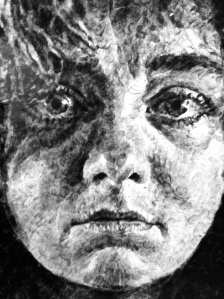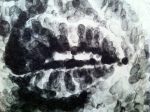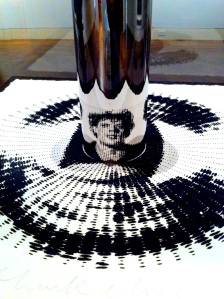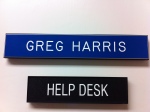This morning at my uncle’s house in Marina, just north of Monterey, I woke to the smell of coffee. This must be a common Harris thing: wake early, brew a strong pot, catch up on what’s happening in the world. A family morning ritual I can stand behind. This particular morning, Rabobank mug in hand, I watched footage of a major tunnel collapse in Japan, political stirrings in Egypt, heat-mapped weather projections of the storm raging outside. Good to know what’s going on over the horizon. It starts to make sense towards the end of the first mugful.
I had planned this weekend to take some ‘me time’—perhaps a jaunt in the Freedom camper into the redwoods, or a night camped by the beach. California had other plans in store for me. The storm that raged up the coast was enough to make outdoor activities less than desirable. Luckily, the Saturday I spent touring Monterey with my Uncle was relatively clear, and what fun we had!

I learned about Chuck Close during my studies at University of Washington. It’s difficult to learn about twentieth-century artists without his name popping up, and for good reason. His large and dynamic portraits, specifically the ones made up of hundreds of colorful tiny abstract squares, have always appealed to me with the sheer depth of creativity taken to produce them. Yes, yes, he has a huge team assembled to help him. Yes, yes, the inspiration for leveling a face into a two-dimensional image may come from a learning disability preventing him from recognizing faces. No matter. Even if you’re not ‘into portraiture’, it’s easy to see why these works are genius.
In contrast with his contemporary Andy Warhol’s famous stylized images of celebrities (e.g. Elvis, Marilyn Monroe), Close chooses subjects unknown to the general public (at least at the time of the portrait) and breaks the images down into grids of abstract color. In my eyes, the true talent of Close’s work becomes apparent when the viewer examines the image up close, noting the grid-like systemization of color, then falls back to a distance and is surprised to see that as a whole these many abstractions combine into something like photorealism. It’s amazing. A video played on a projector in art school does them absolutely zero justice.

The exhibit included more than Close’s large paintings. Huge wall sized portraits of men and women done entirely by thumbprint were scattered through the exhibit. By thumbprint, you ask? Yes, by thumbprint.

There were also some amazing pieces involving a mirrored cylinder surrounded by a drawn-out image. This process completely blew me away. The angle of the cylinder to the paper produced a reflected face that was completely indistinguishable on the surrounding paper. Amazing.

SO, you can understand my excitement when Uncle Greg mentioned the Chuck Close: Works on Paper 1975-2012 exhibit at the Monterey Museum of Art. A day to visit with my Uncle AND see Close’s work up close? (buh dun chhhh) Yes, please.
The Monterey museum has two locations: one in downtown Monterey on Pacific Street, and the other, La Mirada, in the surrounding hills. I love the separation of spaces allowing for a more intimate viewing experience, but I had no idea what a gem the La Mirada location was. An old Spanish-style building surrounded by gardens, rough-hewn beams sprouting from ceilings, whitewashed walls catching the sun and echoing sounds… even if it wasn’t filled with fantastic contemporary art I would feel at home here. The intimate, elegant space flowed easily from one room to another, and the deep colors of the polished hardwood floors brought out the rich hues in the artwork. It is definitely a place I will be visiting again.
More photos from our day of fun:








